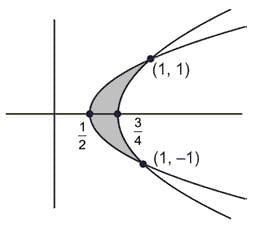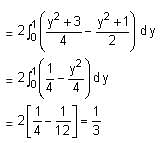JEE Exam > JEE Questions > The area of the region enclosed between the p...
Start Learning for Free
The area of the region enclosed between the parabolas y2 = 2x - 1 and y2 = 4x - 3 is
- a)1/3
- b)1/6
- c)2/3
- d)3/4
Correct answer is option 'A'. Can you explain this answer?
Most Upvoted Answer
The area of the region enclosed between the parabolas y2 = 2x - 1 and ...
To find the area of the region enclosed between the parabolas y^2 = 2x - 1 and y^2 = 4x - 3, we need to first determine the points of intersection between the two parabolas.
To find the points of intersection, we can equate the right-hand sides of the two equations:
2x - 1 = 4x - 3
Rearranging the equation, we get:
2x - 4x = -3 + 1
-2x = -2
Dividing both sides by -2, we get:
x = 1
Substituting this value of x back into either of the equations, we can find the corresponding y-coordinate:
y^2 = 2(1) - 1
y^2 = 1
Taking the square root of both sides, we get:
y = ±1
So, the points of intersection between the parabolas are (1, 1) and (1, -1).
To find the area of the region enclosed between the parabolas, we integrate the difference between the two curves with respect to x over the interval where the curves intersect.
First, let's find the equation of the upper curve and the lower curve. From the equations of the parabolas, we can see that y^2 = 4x - 3 represents the upper curve and y^2 = 2x - 1 represents the lower curve.
Since the points of intersection are symmetric about the x-axis, we can integrate from x = 0 to x = 1 and multiply the result by 2 to get the total area.
Using the formula for the area between two curves, the area of the region enclosed between the parabolas is given by:
A = 2∫[0,1] (upper curve - lower curve) dx
= 2∫[0,1] ((4x - 3) - (2x - 1)) dx
= 2∫[0,1] (2x - 2) dx
= 2(∫[0,1] 2x dx - ∫[0,1] 2 dx)
= 2[x^2]0^1 - 2[2x]0^1
= 2(1^2 - 0^2) - 2(2(1) - 2(0))
= 2(1) - 2(2)
= 2 - 4
= -2
Since the area cannot be negative, we take the absolute value:
|A| = |-2| = 2
Therefore, the area of the region enclosed between the parabolas y^2 = 2x - 1 and y^2 = 4x - 3 is 2.
The correct answer is option A.
To find the points of intersection, we can equate the right-hand sides of the two equations:
2x - 1 = 4x - 3
Rearranging the equation, we get:
2x - 4x = -3 + 1
-2x = -2
Dividing both sides by -2, we get:
x = 1
Substituting this value of x back into either of the equations, we can find the corresponding y-coordinate:
y^2 = 2(1) - 1
y^2 = 1
Taking the square root of both sides, we get:
y = ±1
So, the points of intersection between the parabolas are (1, 1) and (1, -1).
To find the area of the region enclosed between the parabolas, we integrate the difference between the two curves with respect to x over the interval where the curves intersect.
First, let's find the equation of the upper curve and the lower curve. From the equations of the parabolas, we can see that y^2 = 4x - 3 represents the upper curve and y^2 = 2x - 1 represents the lower curve.
Since the points of intersection are symmetric about the x-axis, we can integrate from x = 0 to x = 1 and multiply the result by 2 to get the total area.
Using the formula for the area between two curves, the area of the region enclosed between the parabolas is given by:
A = 2∫[0,1] (upper curve - lower curve) dx
= 2∫[0,1] ((4x - 3) - (2x - 1)) dx
= 2∫[0,1] (2x - 2) dx
= 2(∫[0,1] 2x dx - ∫[0,1] 2 dx)
= 2[x^2]0^1 - 2[2x]0^1
= 2(1^2 - 0^2) - 2(2(1) - 2(0))
= 2(1) - 2(2)
= 2 - 4
= -2
Since the area cannot be negative, we take the absolute value:
|A| = |-2| = 2
Therefore, the area of the region enclosed between the parabolas y^2 = 2x - 1 and y^2 = 4x - 3 is 2.
The correct answer is option A.
Free Test
FREE
| Start Free Test |
Community Answer
The area of the region enclosed between the parabolas y2 = 2x - 1 and ...
Area of the shaded region





|
Explore Courses for JEE exam
|

|
Similar JEE Doubts
The area of the region enclosed between the parabolas y2 = 2x - 1 and y2 = 4x - 3 isa)1/3b)1/6c)2/3d)3/4Correct answer is option 'A'. Can you explain this answer?
Question Description
The area of the region enclosed between the parabolas y2 = 2x - 1 and y2 = 4x - 3 isa)1/3b)1/6c)2/3d)3/4Correct answer is option 'A'. Can you explain this answer? for JEE 2025 is part of JEE preparation. The Question and answers have been prepared according to the JEE exam syllabus. Information about The area of the region enclosed between the parabolas y2 = 2x - 1 and y2 = 4x - 3 isa)1/3b)1/6c)2/3d)3/4Correct answer is option 'A'. Can you explain this answer? covers all topics & solutions for JEE 2025 Exam. Find important definitions, questions, meanings, examples, exercises and tests below for The area of the region enclosed between the parabolas y2 = 2x - 1 and y2 = 4x - 3 isa)1/3b)1/6c)2/3d)3/4Correct answer is option 'A'. Can you explain this answer?.
The area of the region enclosed between the parabolas y2 = 2x - 1 and y2 = 4x - 3 isa)1/3b)1/6c)2/3d)3/4Correct answer is option 'A'. Can you explain this answer? for JEE 2025 is part of JEE preparation. The Question and answers have been prepared according to the JEE exam syllabus. Information about The area of the region enclosed between the parabolas y2 = 2x - 1 and y2 = 4x - 3 isa)1/3b)1/6c)2/3d)3/4Correct answer is option 'A'. Can you explain this answer? covers all topics & solutions for JEE 2025 Exam. Find important definitions, questions, meanings, examples, exercises and tests below for The area of the region enclosed between the parabolas y2 = 2x - 1 and y2 = 4x - 3 isa)1/3b)1/6c)2/3d)3/4Correct answer is option 'A'. Can you explain this answer?.
Solutions for The area of the region enclosed between the parabolas y2 = 2x - 1 and y2 = 4x - 3 isa)1/3b)1/6c)2/3d)3/4Correct answer is option 'A'. Can you explain this answer? in English & in Hindi are available as part of our courses for JEE.
Download more important topics, notes, lectures and mock test series for JEE Exam by signing up for free.
Here you can find the meaning of The area of the region enclosed between the parabolas y2 = 2x - 1 and y2 = 4x - 3 isa)1/3b)1/6c)2/3d)3/4Correct answer is option 'A'. Can you explain this answer? defined & explained in the simplest way possible. Besides giving the explanation of
The area of the region enclosed between the parabolas y2 = 2x - 1 and y2 = 4x - 3 isa)1/3b)1/6c)2/3d)3/4Correct answer is option 'A'. Can you explain this answer?, a detailed solution for The area of the region enclosed between the parabolas y2 = 2x - 1 and y2 = 4x - 3 isa)1/3b)1/6c)2/3d)3/4Correct answer is option 'A'. Can you explain this answer? has been provided alongside types of The area of the region enclosed between the parabolas y2 = 2x - 1 and y2 = 4x - 3 isa)1/3b)1/6c)2/3d)3/4Correct answer is option 'A'. Can you explain this answer? theory, EduRev gives you an
ample number of questions to practice The area of the region enclosed between the parabolas y2 = 2x - 1 and y2 = 4x - 3 isa)1/3b)1/6c)2/3d)3/4Correct answer is option 'A'. Can you explain this answer? tests, examples and also practice JEE tests.

|
Explore Courses for JEE exam
|

|
Signup for Free!
Signup to see your scores go up within 7 days! Learn & Practice with 1000+ FREE Notes, Videos & Tests.
























